The Effects of Spatial Sound on
Human Wellbeing
The Works Research Institute
authors:
P. Oomen
R. Geffen
D. Gentile
category:
Publication, Research
date:
2021
published by:
The Works Research Institute
P. Oomen
R. Geffen
D. Gentile
category:
Publication, Research
date:
2021
published by:
The Works Research Institute
The Works Research Institute facilitates study into the emerging field of spatial sound. The research aims to provide a new understanding of the principles of sound
wave propagation and make benefit of its potential effects on human wellbeing.

Fig.1

Fig.2
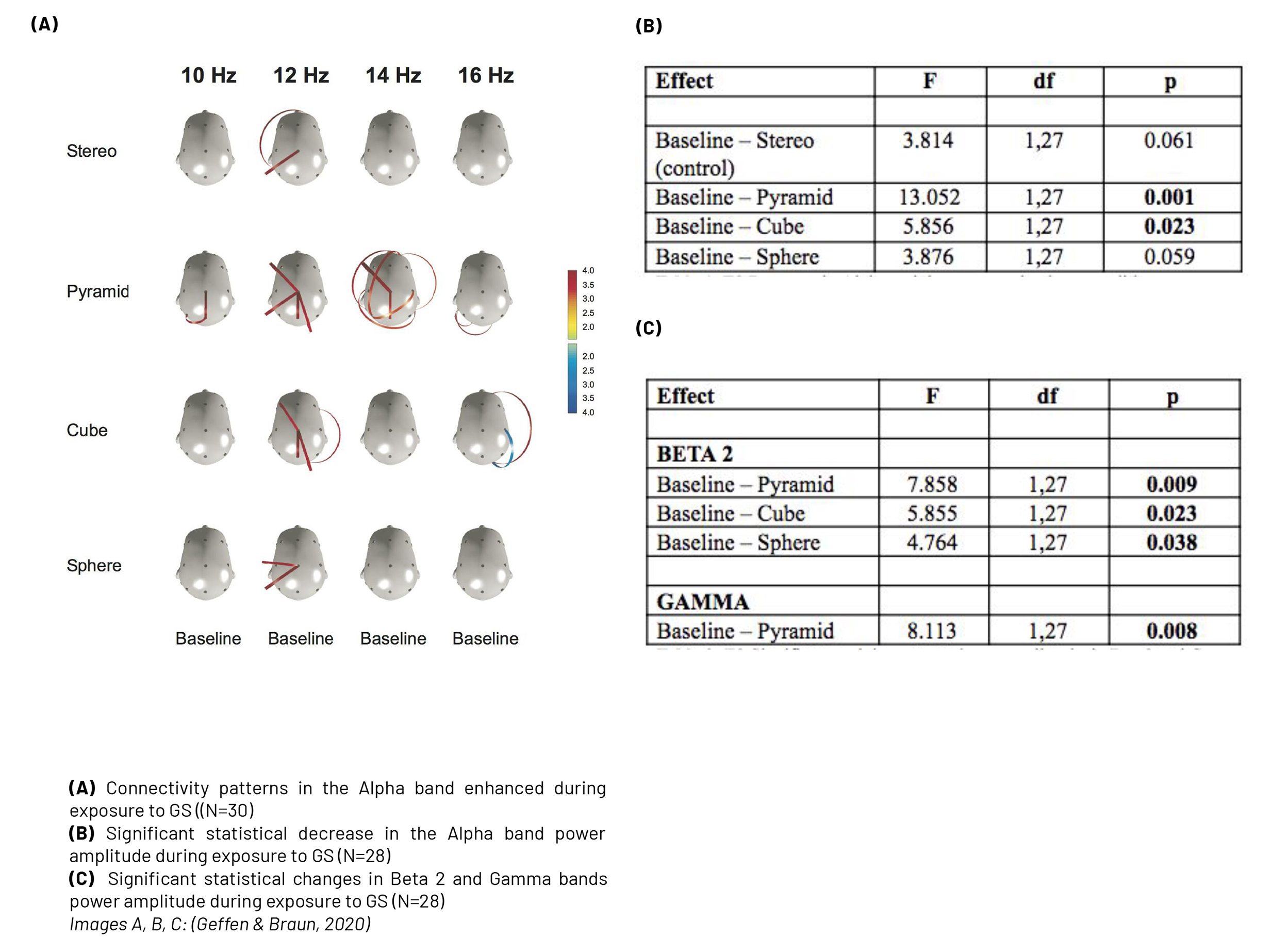
Fig.3

Fig.4
SUMMARY
The emerging research into spatial sound as a medium, in conjunction with recent technical developments in spatial sound processing and acoustic holography, provides a new field of study that may further the understanding of the principles of sound wave propagation and how to make use of its potential effects on human wellbeing. Prior studies conducted during recent years show that spatial coherence of sound waves may have a distinct effect on harnessing energy in natural systems, such as improved homeostasis in the human body.
Spatial coherence of sound is understood as the alignment of sound waves in specific symmetrical patterns and the amplification of associated harmonic spectra as a result, which coincides with an observed improvement of the physiological and psychological state of subjects exposed to the sound waves. We consider these aspects to be intertwined as part of a unified non-discrete system, meaning the connectome of various natural systems bound by the fundamental principle of syntropy (negentropy). This notion informs and gives rise to the hypothesis that spatial projection of sound may provide a means for Acoustic Effector Stimulation (AES) to help restore, maintain and optimize balance in cell organisms, implying potential applications for treatment and prevention of pathological conditions associated with disease and trauma.
BACKGROUND
In support of the hypothesis, we propose a discussion of relevant findings in the fields of acoustics, archaeoacoustics, physics, neurophysiology, embryology, biology and genetics, in conjunction with clinical observations in sound and music therapy.
A recent study tested the hypothesis and measured behavioural change, brain wave activity, heart rate and blood pressure levels of 50 subjects in response to continuous sound stimuli in an interval of an octave (272.2Hz : 544.4Hz) projected as a virtual sound source having a geometrical shape, also referred to as Geometrical Sound (GS) (See Fig.1). Subjects were exposed to three GS conditions (Pyramid, Cube, Sphere) and control (stereo). Results on all measures showed GS had a direct effect on the propagation patterns of the sound waves, as well as influenced the topology, power amplitude and connectivity patterns of brain waves of subjects. Results show an increase in reported positive feelings and decrease in reported negative feelings in conjunction with reduced blood pressure and heart rate for all subjects in response to GS compared to control. (See Fig. 3 , 4) The study effectively showed that spatial-geometrical modelling of sound affects the human physiology differently than using the same sound source in standard stereo positioning 1.
In the reference study, advanced spatial sound technology is used as a transmitter-enabler of the observed phenomena and as such, it provides a non-invasive method to establish equilibrium in physiology, i.e. homeostasis in the human body 2. At present, prototype devices are being developed that integrate new methods in spatial sound processing and acoustic holography 3, 4 to enable accurate projection of virtual sound sources with a dimensional shape, size and density, using omnidirectional loudspeakers 5 and vibro-transducers. (See Fig.2). An example of such a device is the Sphere, a fully spherical construct for one person to sit within, providing an acoustic precision instrument for the projection of virtual sound sources with distinct spatial characteristics. The Sphere offers an environment for high-fidelity spatial projection of sound and integrates measuring human response to the sound stimuli at various levels – such as the brain wave activity and vital functions 6.
For a further explanation of the observed effects, we consider the hearing as a vibro-tactile sense that is at the foundation of the formative embryonic period of human life in the womb. Hearing develops significantly earlier than other senses such as sight, scent and taste. The auditory system of the fetus is already fully formed by the sixth month of pregnancy, whereas reception of sound vibra- tions by means of the entire body may already develop within the earliest stages after conception. The ears and hearing sense develop in what could be recognised as an internal relation to the formation of the vibratory pulsating organ of the fetus’ own heart, with the apical end of the cochlea being more sensitive to low frequencies in the evolving fetus 7. Through the liquid environment of the womb, the fetus can feel and hear vibrations of itself and its surrounding coming from the mother’s body, e.g. the various sounds within her body and external sounds coming from the mother’s environment. It is postulated that the fetus responds to sound and uses the energy it receives from sound waves to shape the development of the ears, nervous system and the brain 8, all evolving from the same ectoderm7. Sound, both as a vibratory and acoustic medium, performs as a communication module for the fetus. Newborn babies were found to cry in the melody of their mother’s language just seconds after birth, suggesting tonation, rhythm and melody, all crucial aspects in characterizing different languages, to function as a means of primordial localisation and connection to the environment 9. Furthermore, hearing is reported as one of the last senses to remain active before death 10. Considering sound plays such a crucial part in our life from gestation to death, it may be a fair assumption that sound has an indispensable vital effect on the human body. Our physiological balance mechanism also resides in the inner ear regulated by the vestibular function, further suggesting homeostasis in various physiological systems of the human body may have a fundamental connection to the auditory faculty.
The notion that sound and its innate rhythms provide balance to our physical and emotional state is fundamental to every form of vibratory medicine, including music therapy, vibratory medicine or sound therapy. Such methods generally aim to (re-)balance the state of the body and the mind and its interdependent elements, potentially restoring or preventing disruption in physiological, mental and emotional processes. Accumulating scientific research in the fields of music therapy and sound therapy confirms the positive effect on brain waves and emotion regulation 11, secretion of hormones 12, pain relief mechanisms 13, improved mood and sense of wellbeing 14, improvement in brain impairment conditions such as a stroke 15, psychological conditions such as a bi-polar disorder 16, enhanced blood oxygenation 17 and more.
The emerging research into spatial sound as a medium, in conjunction with recent technical developments in spatial sound processing and acoustic holography, provides a new field of study that may further the understanding of the principles of sound wave propagation and how to make use of its potential effects on human wellbeing. Prior studies conducted during recent years show that spatial coherence of sound waves may have a distinct effect on harnessing energy in natural systems, such as improved homeostasis in the human body.
Spatial coherence of sound is understood as the alignment of sound waves in specific symmetrical patterns and the amplification of associated harmonic spectra as a result, which coincides with an observed improvement of the physiological and psychological state of subjects exposed to the sound waves. We consider these aspects to be intertwined as part of a unified non-discrete system, meaning the connectome of various natural systems bound by the fundamental principle of syntropy (negentropy). This notion informs and gives rise to the hypothesis that spatial projection of sound may provide a means for Acoustic Effector Stimulation (AES) to help restore, maintain and optimize balance in cell organisms, implying potential applications for treatment and prevention of pathological conditions associated with disease and trauma.
BACKGROUND
In support of the hypothesis, we propose a discussion of relevant findings in the fields of acoustics, archaeoacoustics, physics, neurophysiology, embryology, biology and genetics, in conjunction with clinical observations in sound and music therapy.
A recent study tested the hypothesis and measured behavioural change, brain wave activity, heart rate and blood pressure levels of 50 subjects in response to continuous sound stimuli in an interval of an octave (272.2Hz : 544.4Hz) projected as a virtual sound source having a geometrical shape, also referred to as Geometrical Sound (GS) (See Fig.1). Subjects were exposed to three GS conditions (Pyramid, Cube, Sphere) and control (stereo). Results on all measures showed GS had a direct effect on the propagation patterns of the sound waves, as well as influenced the topology, power amplitude and connectivity patterns of brain waves of subjects. Results show an increase in reported positive feelings and decrease in reported negative feelings in conjunction with reduced blood pressure and heart rate for all subjects in response to GS compared to control. (See Fig. 3 , 4) The study effectively showed that spatial-geometrical modelling of sound affects the human physiology differently than using the same sound source in standard stereo positioning 1.
In the reference study, advanced spatial sound technology is used as a transmitter-enabler of the observed phenomena and as such, it provides a non-invasive method to establish equilibrium in physiology, i.e. homeostasis in the human body 2. At present, prototype devices are being developed that integrate new methods in spatial sound processing and acoustic holography 3, 4 to enable accurate projection of virtual sound sources with a dimensional shape, size and density, using omnidirectional loudspeakers 5 and vibro-transducers. (See Fig.2). An example of such a device is the Sphere, a fully spherical construct for one person to sit within, providing an acoustic precision instrument for the projection of virtual sound sources with distinct spatial characteristics. The Sphere offers an environment for high-fidelity spatial projection of sound and integrates measuring human response to the sound stimuli at various levels – such as the brain wave activity and vital functions 6.
For a further explanation of the observed effects, we consider the hearing as a vibro-tactile sense that is at the foundation of the formative embryonic period of human life in the womb. Hearing develops significantly earlier than other senses such as sight, scent and taste. The auditory system of the fetus is already fully formed by the sixth month of pregnancy, whereas reception of sound vibra- tions by means of the entire body may already develop within the earliest stages after conception. The ears and hearing sense develop in what could be recognised as an internal relation to the formation of the vibratory pulsating organ of the fetus’ own heart, with the apical end of the cochlea being more sensitive to low frequencies in the evolving fetus 7. Through the liquid environment of the womb, the fetus can feel and hear vibrations of itself and its surrounding coming from the mother’s body, e.g. the various sounds within her body and external sounds coming from the mother’s environment. It is postulated that the fetus responds to sound and uses the energy it receives from sound waves to shape the development of the ears, nervous system and the brain 8, all evolving from the same ectoderm7. Sound, both as a vibratory and acoustic medium, performs as a communication module for the fetus. Newborn babies were found to cry in the melody of their mother’s language just seconds after birth, suggesting tonation, rhythm and melody, all crucial aspects in characterizing different languages, to function as a means of primordial localisation and connection to the environment 9. Furthermore, hearing is reported as one of the last senses to remain active before death 10. Considering sound plays such a crucial part in our life from gestation to death, it may be a fair assumption that sound has an indispensable vital effect on the human body. Our physiological balance mechanism also resides in the inner ear regulated by the vestibular function, further suggesting homeostasis in various physiological systems of the human body may have a fundamental connection to the auditory faculty.
The notion that sound and its innate rhythms provide balance to our physical and emotional state is fundamental to every form of vibratory medicine, including music therapy, vibratory medicine or sound therapy. Such methods generally aim to (re-)balance the state of the body and the mind and its interdependent elements, potentially restoring or preventing disruption in physiological, mental and emotional processes. Accumulating scientific research in the fields of music therapy and sound therapy confirms the positive effect on brain waves and emotion regulation 11, secretion of hormones 12, pain relief mechanisms 13, improved mood and sense of wellbeing 14, improvement in brain impairment conditions such as a stroke 15, psychological conditions such as a bi-polar disorder 16, enhanced blood oxygenation 17 and more.

Photograph of The Sphere at The Works Research Institute, Budapest
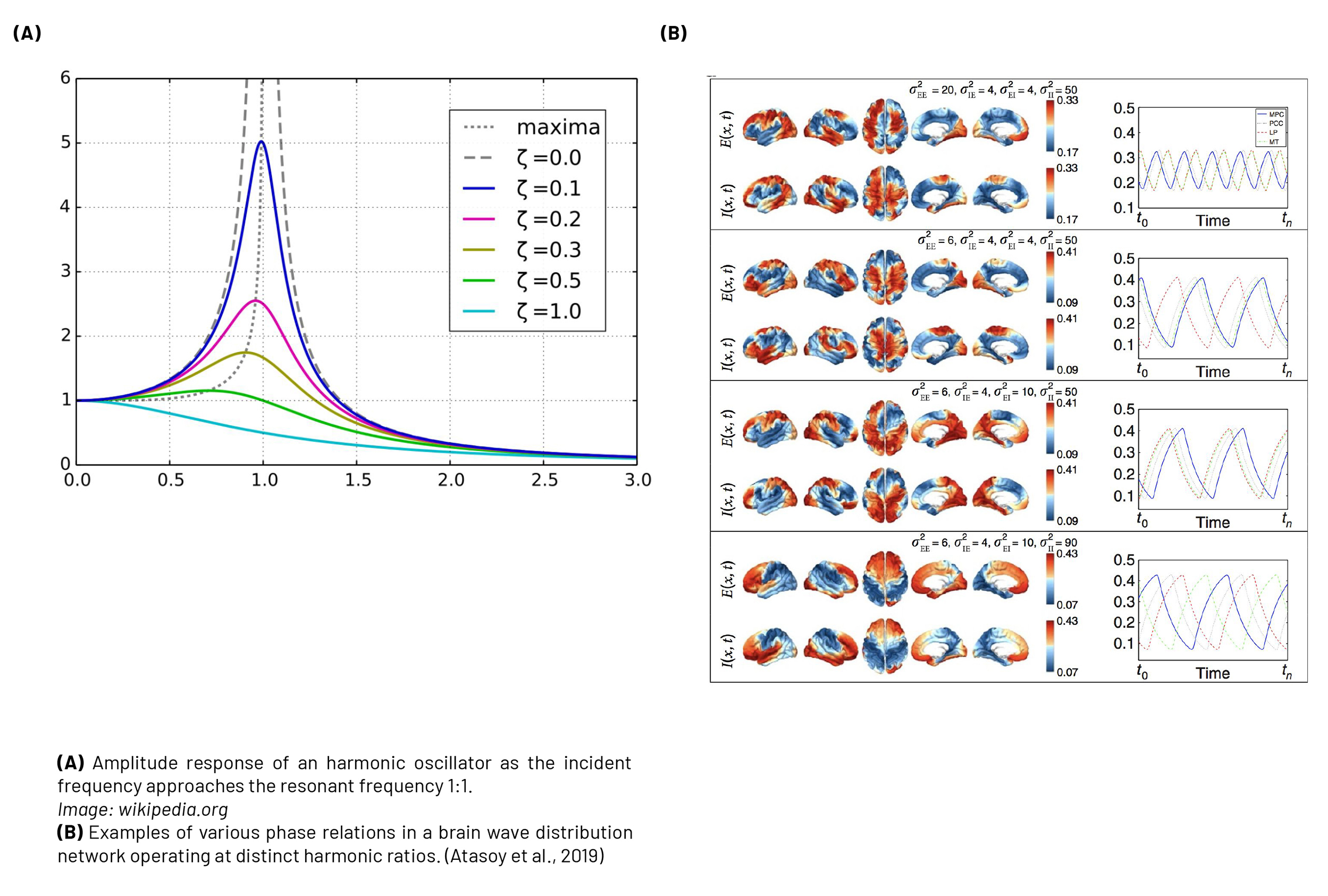
Fig.5

Fig.6
While the positive emotional effect of listening to music is intuitively familiar to almost anyone, the positive effect of sound as a medium may be more elusive to comprehend. In vibratory medicine it is common to relate to the entrainment of frequencies and rhythms as the driving mechanism to harness and regulate homeostasis. From heartbeat and breathing to circadian rhythms and menstruation cycles, the human body generates and operates according to rhythms of various periodicities which govern biological, cellular and mechanical processes. It is assumed that sound, being inherently rhythmic by its frequency oscillation components, can affect other vibratory systems, i.e. oscillation cycles occurring in biological and natural systems, including the rhythms of the human body. The equilibrium state is observed to be positively affected or tune-able, i.e. the process referred to as entrainment.
We consider the entrainment of physiological systems to distinct sound frequencies as a form of harmonic resonance, where a response function is generated between two seemingly discrete systems, e.g. the human body and an (external) sound source. The effects of harmonic resonance have been widely demonstrated in physics 18 and have also been observed in human brain networks 19 and bilateral functioning of the heart and brain 20(See Fig. 5). Harmonic resonance describes the phenomenon where wave oscillations are increasingly amplified at a closely matching frequency and its higher harmonics, which are integer multiples of the fundamental frequency. Harmonic resonance exhibits in standing waves that propagate geometrically in space, with a wavelength that is inversely proportional to the frequency. States of harmonic resonance may be expressed in frequency ratios and patterns of spatial distribution. The most prominent frequencies of the observed standing wave states correspond to the ratio of the lowest Pythagorean harmonic intervals 1:2 (octave), 2:3 ( fth) and 3:4 (fourth) and further permutations of these intervals 21 (See Fig. 6). While being deflected from stillness by the vibratory excitation, a system under influence of harmonic coherence demonstrates a restored state of equilibrium, associated with an increase in energy stored and decrease in energy dissipating from the system. As such, we observe syntropy, or negative entropy, brought about by harmonic resonance, a condition where organisation in the system is enhanced and energy is locally preserved and accumulates. We refer to syntropy as the tendency towards energy concentration, order, organisation and life, or inversely to entropy, as a result of retrocausality leading to persistent organisation 22.

The Works Research Institute Team

Fig.7
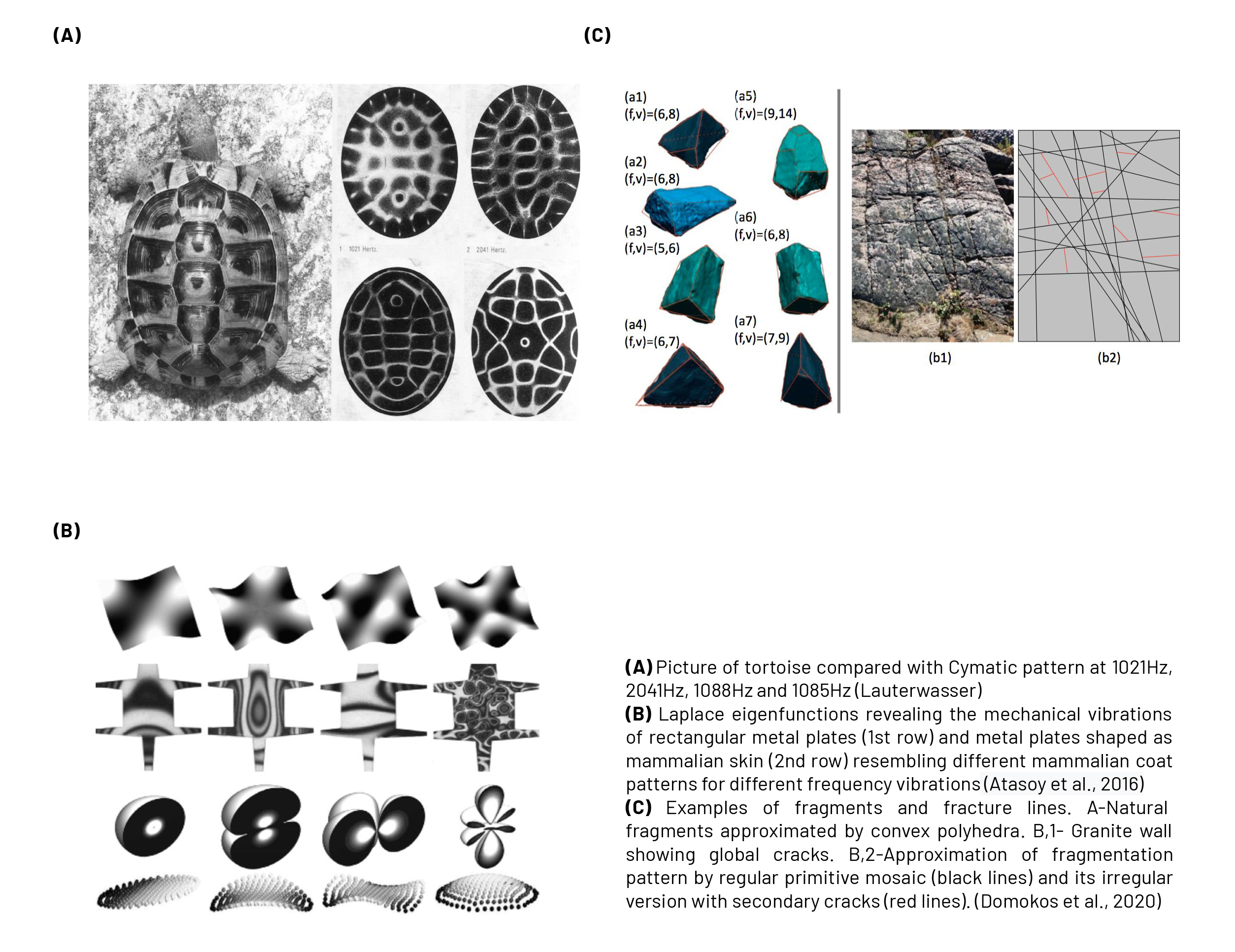
Fig.8

Fig. 9
Here it should be noted that since early development of
civilization, humanity has deployed and created physical structures that harness harmonic resonance, possibly with the intention to enhance physical, emotional and
spiritual wellbeing. These structures are found across cultures around the world using stones and rocks with bell-
like characteristics 23-28. Such structures may have functioned as amplification devices for natural sound sources in the environment, such as the human voice or primitive
instruments, and may have been used to harness geophysical properties for the benefit of acoustic resonance and
its effects on the human body and mind. The positioning
of individual elements of these structures, as well as the
architectural and geographical relation between these
structures were often found to follow various geometric designs and distinct mathematical ratios, such as the
Fibonnaci series and other mathematical constants 29-30. The
geometric organisation of the environment using distinct
shapes, measures and materials enhances harmonic resonance at distinct frequencies and/or frequency ranges,
resulting in increased spatial coherence. We refer to spatial coherence as the alignment of sound waves in specific
symmetrical patterns and the amplification of associated
harmonic spectra as a result. In a similar way, present-day
technologies that allow accurate spatial-geometric modelling of sound may be deployed to alter or simulate an
environment and achieve a technology-enabled, spatially
coherent projection of sound waves.
As wave propagation employs a path of least resistance, under the influence of harmonic resonance it provides a channel for optimal energy distribution at the associated resonant frequencies. In acoustics, such phenomena are observed as standing waves. The symmetrical distribution of wave patterns is commonly observed and studied as nodal line patterns forming on a 2-dimensional plate, known as Chladni plates named after physicist and musician Ernst Chladni, who first documented the phenomenon in 1787 31. The patterns are made visible by sand particles that gather at the nodes of the standing waves coinciding with the resonant modes of a vibrating plate. The study of Chladni plates remains an active field of study up until today and has been subsequently resumed and deepened throughout the 20th Century, notably by Swiss physician and naturalist Hans Jenny who popularised the phenomena and coined the term cymatics, from the Greek wordkymatiké which means ’study concerning the waves’. (See Fig.7)
Jenny described the aim of this research “to produce vibration models and investigate the laws to which they continually conform”32. Other experiments have shown that wave propagation patterns are influenced by frequency and the geometric boundary condition, size and material of the excitation medium, i.e. the vibratory medium 33-34 and propose new analytical solutions for accurate prediction of the observed patterns 35.
The ongoing research into pattern formation of sound waves also serves to demonstrate that wave propagation functions in general as an efficient distribution mechanism to deploy vibrational energy. Research suggests vibrational patterns may determine the geometry of animal coat patterns 36 and tree formation 37, as well as show a distinct relation to repeated geometries in the formation of crystals 38 and breaking patterns of soil 39(See Fig.8)
Mathematician and physicist J.C. Maxwell introduced the notion that the electric and magnetic field components of electromagnetic waves propagate in an orthogonal in-phase relationship. This observation coincides well with modern understanding of sound propagation as a spherical medium 40 (See Fig. 9).
As wave propagation employs a path of least resistance, under the influence of harmonic resonance it provides a channel for optimal energy distribution at the associated resonant frequencies. In acoustics, such phenomena are observed as standing waves. The symmetrical distribution of wave patterns is commonly observed and studied as nodal line patterns forming on a 2-dimensional plate, known as Chladni plates named after physicist and musician Ernst Chladni, who first documented the phenomenon in 1787 31. The patterns are made visible by sand particles that gather at the nodes of the standing waves coinciding with the resonant modes of a vibrating plate. The study of Chladni plates remains an active field of study up until today and has been subsequently resumed and deepened throughout the 20th Century, notably by Swiss physician and naturalist Hans Jenny who popularised the phenomena and coined the term cymatics, from the Greek wordkymatiké which means ’study concerning the waves’. (See Fig.7)
Jenny described the aim of this research “to produce vibration models and investigate the laws to which they continually conform”32. Other experiments have shown that wave propagation patterns are influenced by frequency and the geometric boundary condition, size and material of the excitation medium, i.e. the vibratory medium 33-34 and propose new analytical solutions for accurate prediction of the observed patterns 35.
The ongoing research into pattern formation of sound waves also serves to demonstrate that wave propagation functions in general as an efficient distribution mechanism to deploy vibrational energy. Research suggests vibrational patterns may determine the geometry of animal coat patterns 36 and tree formation 37, as well as show a distinct relation to repeated geometries in the formation of crystals 38 and breaking patterns of soil 39(See Fig.8)
Mathematician and physicist J.C. Maxwell introduced the notion that the electric and magnetic field components of electromagnetic waves propagate in an orthogonal in-phase relationship. This observation coincides well with modern understanding of sound propagation as a spherical medium 40 (See Fig. 9).


Fig.10
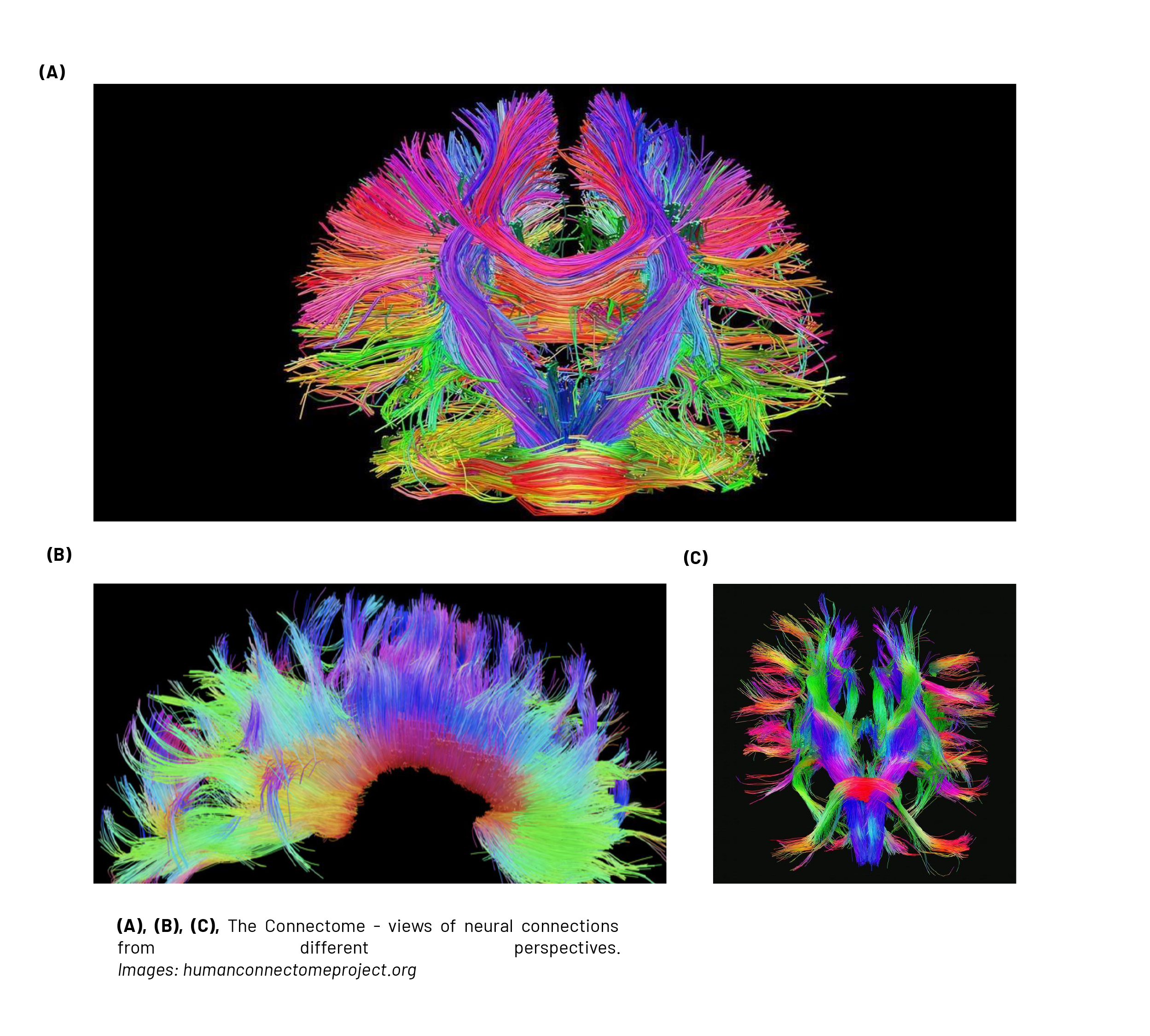
Fig. 11
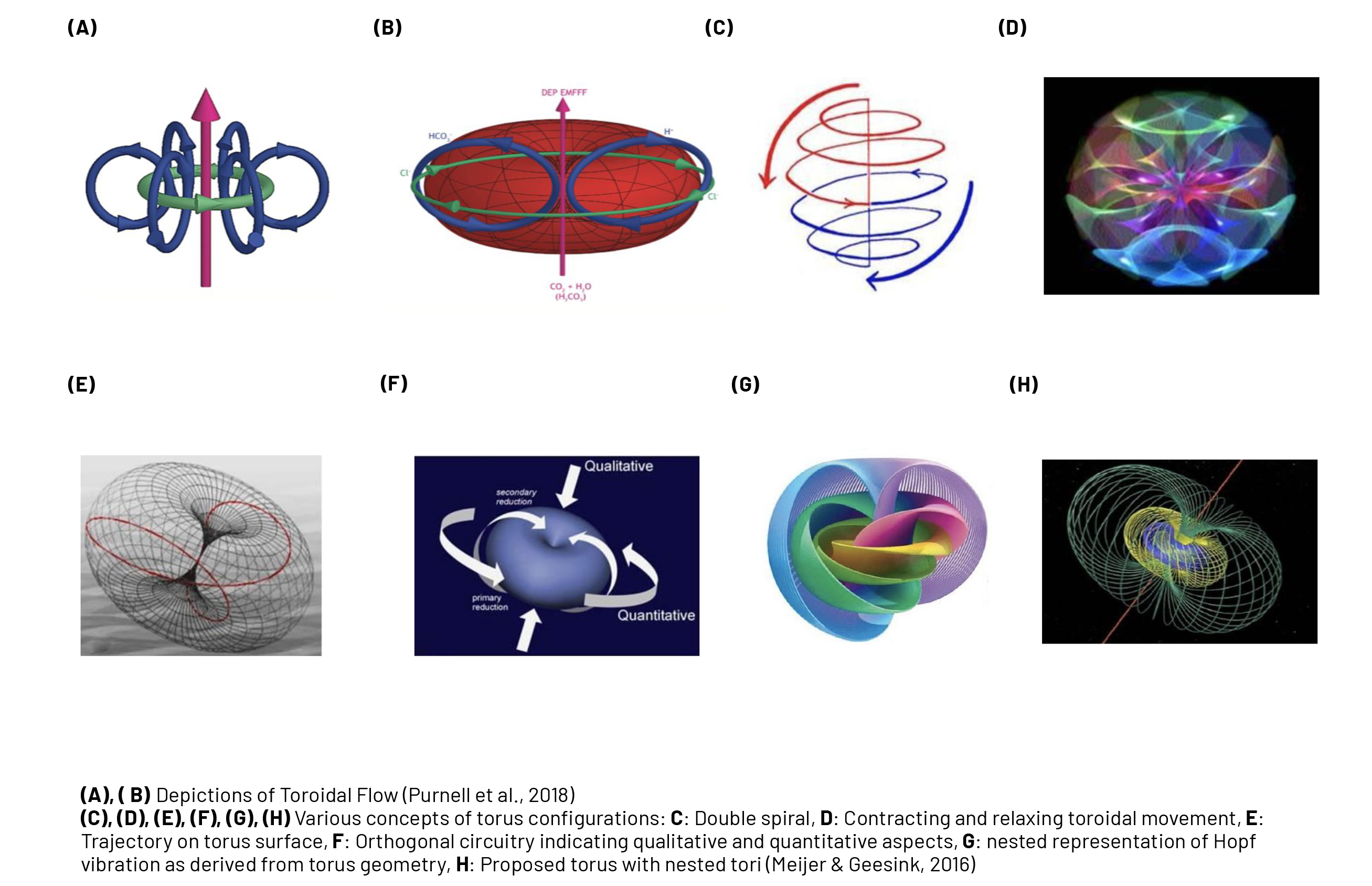
Fig.12
While
Maxwell relates general wave propagation phenomena as
part of the electro-magnetic spectrum (EMS), present-day
research shows increasing evidence of the interconnection
between sound wave propagation and related phenomena
in the EMS. The frequencies of electromagnetic waves and
associated photon energies were successfully coupled to
harmonically relate to phonons 41. In conjunction with this
observation, ionic neuronal mechanisms were found to be
intrinsically connected to accurate sound determination,
hence melodic interpretation 42. Sonoluminescence was
shown to occur with precision during sound wave cycles,
postulated to be equally compatible with the formation of
plasma 43. Diodes manipulating propagation of phonons
were found to beneficially manage the phononic spectrum
in the creation of technologies able to manipulate sound
and heat 44. Comparative study across 175 biological publications concerning the measured beneficial effects of
electromagnetic waves on the state of living cells, suggests
that nature employs discrete standing waves that match
precisely with the acoustic harmonic scale. The identification of typical toroidal flux in phonon, photon and electron wave energies may explain functional organisation
of cellular structures that enable the origination and sustainment of life processes and optimal protection against
decoherence at minimal loss of energy 45. (See Fig.10)
These emerging understandings relating to general phenomena of wave propagation further demonstrate the role of harmonic resonance as a regulator of cohesive energy distribution in the connectome of various natural systems. We refer to the connectome as the complete network of structural links between various systems that function interdependently as one organism, synonymous with reference to the term denoting the complete network of elements and connections between the interdependent parts of the human brain 46 (See Fig.11).
In addition, we observe that systems under influence of harmonic resonance demonstrate energy moving in toroidal waves within a spherical medium 47 (See Fig.12) . The energy present within an acoustic system is optimally preserved when the energy used to produce higher harmonic states, returns back into the system with the meta-periodic resonance of each harmonic and the fundamental frequency, resulting in an overall decrease of energy dissipation across the frequency range and amplification of sound wave oscillations. Similarly, we find toroidal waves resulting from the bipolar energy flux present in magnetic fields, including the Earth’s magnetic field (geo- magnetic field) 48 and in the electromagnetic field of the human body (biomagnetic field) 49-50. Notably, the human biomagnetic field is reported to increase in individuals in a natural environment or with extensive practice of methods such as Qi Gong. The enhanced biomagnetic emission could not be derived from the physical body alone as biomagnetic emission increased while its corresponding bioelectric current remained static 51.
Recognising the dependencies and similarities between sound waves, electromagnetic waves and their related phenomena supports further understanding of the as yet untapped potential for treatment and prevention of pathological conditions through acoustic means. As already shown by various studies, exposure to visual or acoustic stimuli can support and enhance healing mechanisms, stress reduction, pain endurance and general sense of well-being 52-53. Furthermore, deploying the vibratory EMS has proven an effective means to improve various healing processes 54, including healing severe wounds 55 and eliminating destructive processes such as cancerous metastases 56. While the notion that destructive acute processes could be reversible by presentation of stimuli may be sur- prising, research has shown that positive stimuli could indeed affect and reverse effects of negative stimuli, even when inherited 57.
Taking into consideration Iatrogenic diseases (disease caused by synthesized medication) were found to be the fifth leading cause of death in the world 58, this calls for new, non-invasive and sustainable methods that could employ the potential benefits of sound wave propagation for human wellbeing and health.
CONCLUSION
From the existing body of scientific research and clinical observations, we recognize sound waves as a sustainable and controllable medium to support equilibrium in various natural systems, such as enhanced homeostasis in the human body. Sound waves under the influence of harmonic resonance produce symmetrically aligned propagation patterns with distinct energy harnessing qualities, which we indicate as the spatial coherence of sound waves. The controlled projection of spatially coherent sound waves is enabled by means of new emerging spatial sound technologies and integrated mathematical constants. The immediate effects of spatially coherent projection of sound waves on the human body have been experimentally verified, and a dependency and similarity is suggested with observed effects of related phenomena in the EMS as potential means to enhance healing processes, treat pathological conditions and reverse trauma. In particular, the potentially beneficial effect of sound waves on the human body may be viewed in the light of the fundamental role of hearing during gestation and its regulating properties in human physiology.
We hypothesize that the harmonic spectra resulting from spatially coherent sound projection can be inverted and enhanced by technology to bring upon homeostasis in natural systems, including enhanced physical and emotional wellbeing in humans. As such, spatial sound technologies may provide a means for Acoustic Effector Stimulation (AES) to help restore, maintain and optimize balance in cell organisms, implying potential application for treatment and prevention of pathological conditions associated with disease and trauma. The hypothesis may inform further studies that aim to progress the clinical methods using spatial sound for the benefit of people dealing with a wide range of physiological and psychological conditions, thereby extending upon existing practices of vibratory medicine including sound and music therapy. To further probe and establish the potential of AES as a non-invasive clinical methodology, a bottom-up design of experimental paradigms is to be concluded over the coming years, further monitoring physiological somatic response and behavioral effect of subjects exposed to AES, documenting the underlying acoustic and physical phenomena, aswell as providing further understanding of the governing rules of general wave propagation and its effects on various natural systems.
These emerging understandings relating to general phenomena of wave propagation further demonstrate the role of harmonic resonance as a regulator of cohesive energy distribution in the connectome of various natural systems. We refer to the connectome as the complete network of structural links between various systems that function interdependently as one organism, synonymous with reference to the term denoting the complete network of elements and connections between the interdependent parts of the human brain 46 (See Fig.11).
In addition, we observe that systems under influence of harmonic resonance demonstrate energy moving in toroidal waves within a spherical medium 47 (See Fig.12) . The energy present within an acoustic system is optimally preserved when the energy used to produce higher harmonic states, returns back into the system with the meta-periodic resonance of each harmonic and the fundamental frequency, resulting in an overall decrease of energy dissipation across the frequency range and amplification of sound wave oscillations. Similarly, we find toroidal waves resulting from the bipolar energy flux present in magnetic fields, including the Earth’s magnetic field (geo- magnetic field) 48 and in the electromagnetic field of the human body (biomagnetic field) 49-50. Notably, the human biomagnetic field is reported to increase in individuals in a natural environment or with extensive practice of methods such as Qi Gong. The enhanced biomagnetic emission could not be derived from the physical body alone as biomagnetic emission increased while its corresponding bioelectric current remained static 51.
Recognising the dependencies and similarities between sound waves, electromagnetic waves and their related phenomena supports further understanding of the as yet untapped potential for treatment and prevention of pathological conditions through acoustic means. As already shown by various studies, exposure to visual or acoustic stimuli can support and enhance healing mechanisms, stress reduction, pain endurance and general sense of well-being 52-53. Furthermore, deploying the vibratory EMS has proven an effective means to improve various healing processes 54, including healing severe wounds 55 and eliminating destructive processes such as cancerous metastases 56. While the notion that destructive acute processes could be reversible by presentation of stimuli may be sur- prising, research has shown that positive stimuli could indeed affect and reverse effects of negative stimuli, even when inherited 57.
Taking into consideration Iatrogenic diseases (disease caused by synthesized medication) were found to be the fifth leading cause of death in the world 58, this calls for new, non-invasive and sustainable methods that could employ the potential benefits of sound wave propagation for human wellbeing and health.
CONCLUSION
From the existing body of scientific research and clinical observations, we recognize sound waves as a sustainable and controllable medium to support equilibrium in various natural systems, such as enhanced homeostasis in the human body. Sound waves under the influence of harmonic resonance produce symmetrically aligned propagation patterns with distinct energy harnessing qualities, which we indicate as the spatial coherence of sound waves. The controlled projection of spatially coherent sound waves is enabled by means of new emerging spatial sound technologies and integrated mathematical constants. The immediate effects of spatially coherent projection of sound waves on the human body have been experimentally verified, and a dependency and similarity is suggested with observed effects of related phenomena in the EMS as potential means to enhance healing processes, treat pathological conditions and reverse trauma. In particular, the potentially beneficial effect of sound waves on the human body may be viewed in the light of the fundamental role of hearing during gestation and its regulating properties in human physiology.
We hypothesize that the harmonic spectra resulting from spatially coherent sound projection can be inverted and enhanced by technology to bring upon homeostasis in natural systems, including enhanced physical and emotional wellbeing in humans. As such, spatial sound technologies may provide a means for Acoustic Effector Stimulation (AES) to help restore, maintain and optimize balance in cell organisms, implying potential application for treatment and prevention of pathological conditions associated with disease and trauma. The hypothesis may inform further studies that aim to progress the clinical methods using spatial sound for the benefit of people dealing with a wide range of physiological and psychological conditions, thereby extending upon existing practices of vibratory medicine including sound and music therapy. To further probe and establish the potential of AES as a non-invasive clinical methodology, a bottom-up design of experimental paradigms is to be concluded over the coming years, further monitoring physiological somatic response and behavioral effect of subjects exposed to AES, documenting the underlying acoustic and physical phenomena, aswell as providing further understanding of the governing rules of general wave propagation and its effects on various natural systems.

107 Hz as depicted on the Cymascope at The Works Research Institute’s laboratory
To know more about The Works Research Institute:
https://theworks.info/
TEAM
The Works Research Institute collaborates with an interdisciplinary team of researchers and scientists in the eld of Neuro-Science, Psycho and Physio-Acoustics, Physics, Mathematics, Electro-Acoustics and Audio Signal Processing.
- Paul Oomen Head of Research and Development
-
Rona Geffen Lead Medical and Sound Research
-
Dr. Amira Val Baker Lead Physics & Mathematics
-
Prof. Dr. Christopher Braun Clinical Neuro-Biology,
Data Analysis, MEG-Center,
University of Tubingen
- Ia Mgvdliashvili Software Prototyping
-
Daniela Gentile
Research Assistant
-
Nicolas Fellas
Technical Manager
-
Rebecca Kristóf
Office Manager
GLOSSARY
Acoustic Effector Stimulation (AES)
A method of projecting sound waves on the human body that trigger effector cells to bring about physiological change resulting in enhanced homeostasis.
Acoustic Holography
A method for estimating the energy of the sound field at a source by measuring or computing acoustic parameters for an array of particles, i.e point sources, defined at or around the source emitting the sound.
Biofield (Biological-Field)
A massless field (not necessarily electromagnetic) that surrounds and permeates living bodies and affects the body. (NIH)
Coherence
The quality of being consistent and forming a unified whole. A property of a matrix describing the maximum correlation between its components. An ideal property of waves that enables stationary (i.e. temporally and spatially constant) interference (physics).
Connectome
The complete network of structural links between various systems that function interdependently as one organism. The term is generally referred to as the comprehensive map of neural connections in the brain.
Entrainment
The process whereby two interacting oscillating systems assume the same periodicity. Entrainment is a phenomenon that can be observed in physical and biological systems.
Harmonic Coherence
An oscillatory function representing a state of equilibrium in a biological system, i.e. in human physiology this condition indicates homeostasis.
A method of projecting sound waves on the human body that trigger effector cells to bring about physiological change resulting in enhanced homeostasis.
Acoustic Holography
A method for estimating the energy of the sound field at a source by measuring or computing acoustic parameters for an array of particles, i.e point sources, defined at or around the source emitting the sound.
Biofield (Biological-Field)
A massless field (not necessarily electromagnetic) that surrounds and permeates living bodies and affects the body. (NIH)
Coherence
The quality of being consistent and forming a unified whole. A property of a matrix describing the maximum correlation between its components. An ideal property of waves that enables stationary (i.e. temporally and spatially constant) interference (physics).
Connectome
The complete network of structural links between various systems that function interdependently as one organism. The term is generally referred to as the comprehensive map of neural connections in the brain.
Entrainment
The process whereby two interacting oscillating systems assume the same periodicity. Entrainment is a phenomenon that can be observed in physical and biological systems.
Harmonic Coherence
An oscillatory function representing a state of equilibrium in a biological system, i.e. in human physiology this condition indicates homeostasis.
Harmonic Resonance
The phenomenon where wave oscillations are increasingly amplified at a closely matching frequency and its higher harmonics, i.e. integer multiples of a fundamental frequency.
Homeostasis
Any self-regulating process by which biological systems tend to maintain stability while adjusting to conditions that are optimal for survival.
Music Therapy
An established health profession in which music is used within a therapeutic relationship to address physical, emotional, cognitive and social needs.
Resonance
The phenomenon of increased amplitude that occurs when the frequency of a periodically applied force is equal or close to a natural frequency of the system on which it acts.
Spatial Coherence
Alignment of sound waves in temporally and spatially constant symmetrical patterns and the amplification of an associated harmonic spectrum of frequencies as a result.
Syntropy (negative entropy)
A condition where organisation in the system is enhanced and energy is locally preserved and accumulates. A tendency towards energy concentration, order, organisation and life, or inversely to entropy, as a result of retrocausality leading to persistent organisation.
Vibratory Medicine (Sound Therapy)
A range of therapies in which sound vibrations are used to treat physical, emotional and cognitive needs. Vibratory Medicine uses principles of resonance and entrainment to self-regulate a system into its natural harmonic coherent state
The phenomenon where wave oscillations are increasingly amplified at a closely matching frequency and its higher harmonics, i.e. integer multiples of a fundamental frequency.
Homeostasis
Any self-regulating process by which biological systems tend to maintain stability while adjusting to conditions that are optimal for survival.
Music Therapy
An established health profession in which music is used within a therapeutic relationship to address physical, emotional, cognitive and social needs.
Resonance
The phenomenon of increased amplitude that occurs when the frequency of a periodically applied force is equal or close to a natural frequency of the system on which it acts.
Spatial Coherence
Alignment of sound waves in temporally and spatially constant symmetrical patterns and the amplification of an associated harmonic spectrum of frequencies as a result.
Syntropy (negative entropy)
A condition where organisation in the system is enhanced and energy is locally preserved and accumulates. A tendency towards energy concentration, order, organisation and life, or inversely to entropy, as a result of retrocausality leading to persistent organisation.
Vibratory Medicine (Sound Therapy)
A range of therapies in which sound vibrations are used to treat physical, emotional and cognitive needs. Vibratory Medicine uses principles of resonance and entrainment to self-regulate a system into its natural harmonic coherent state
References:
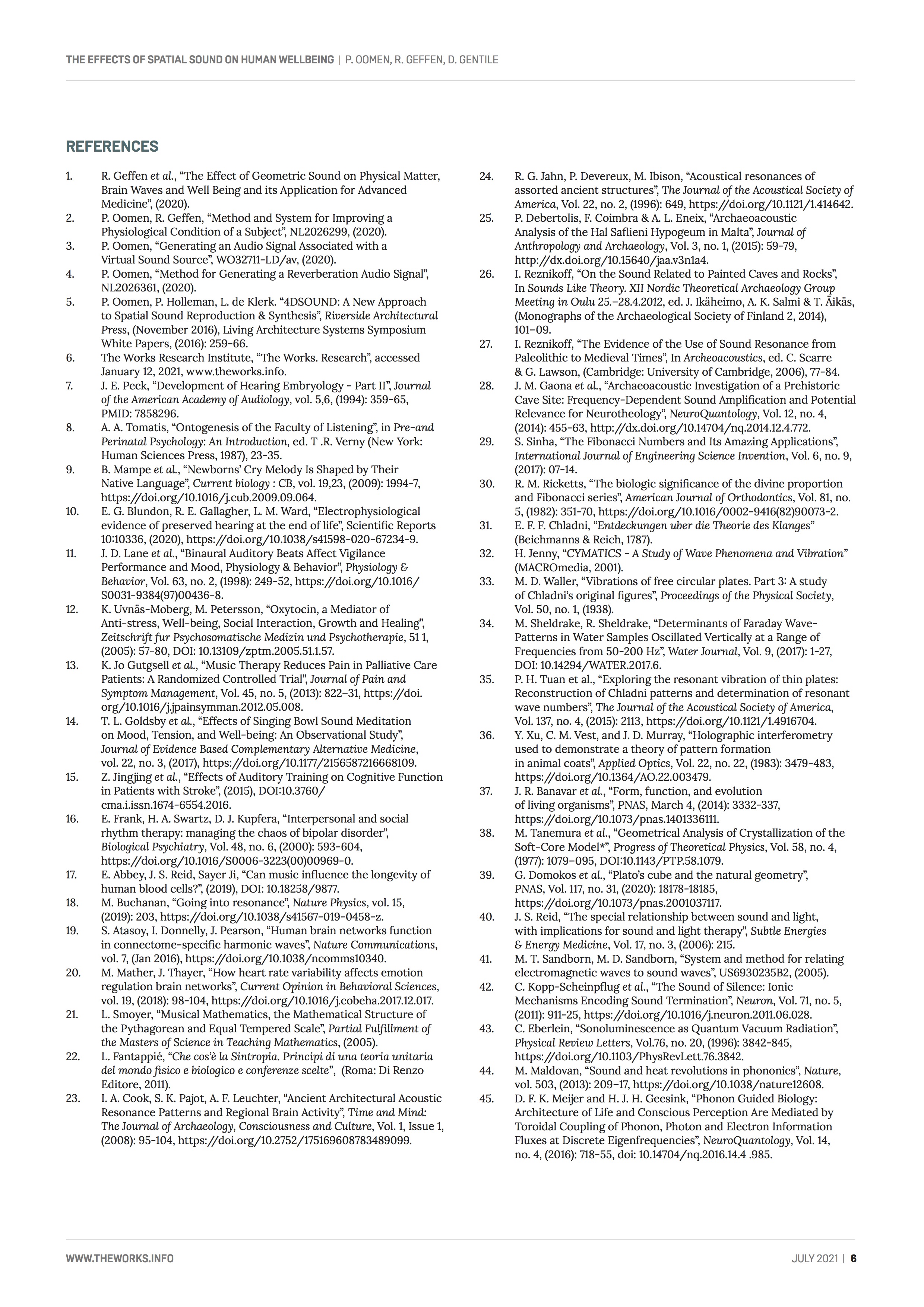
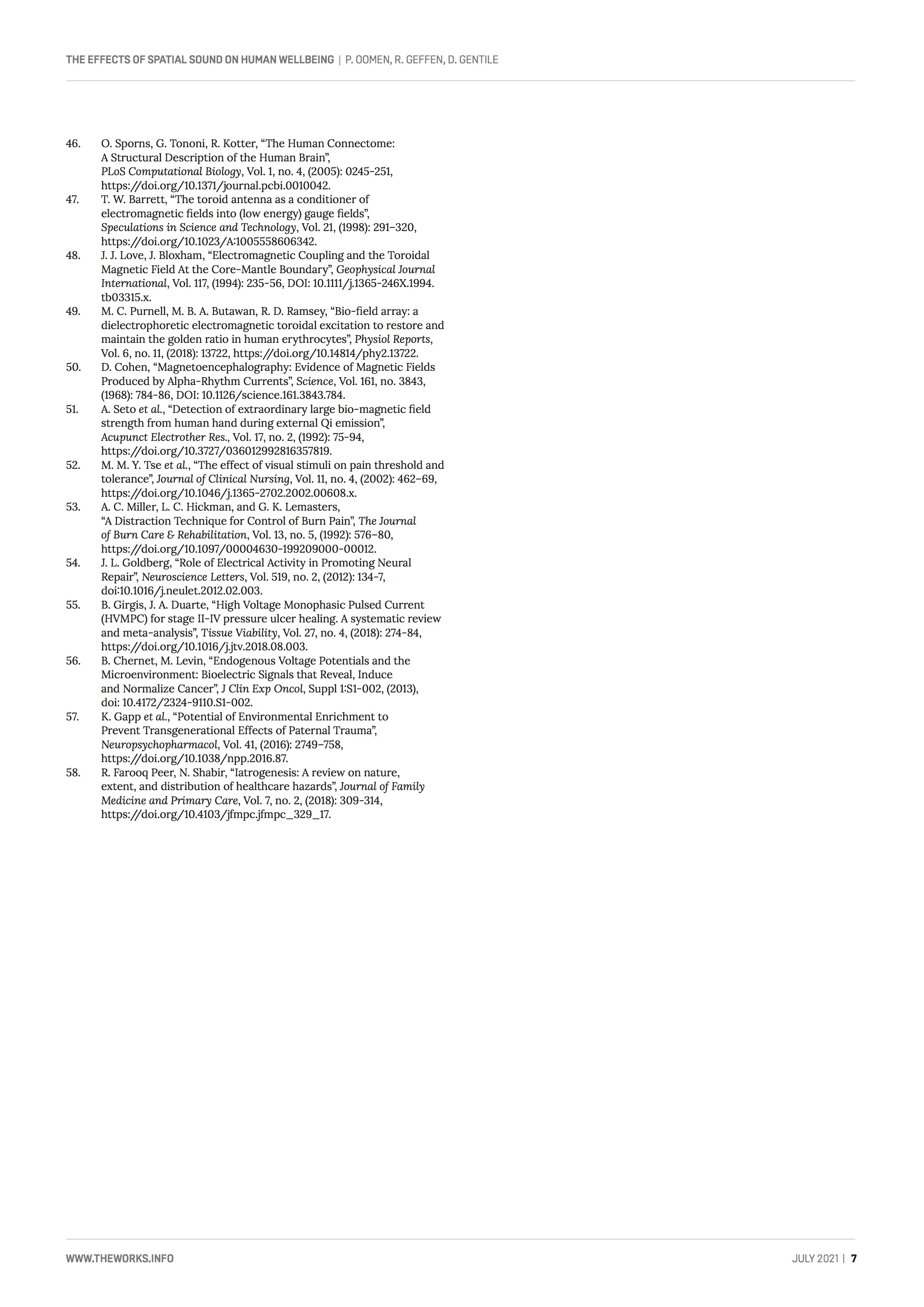
Appendix :
![]()



Related:

